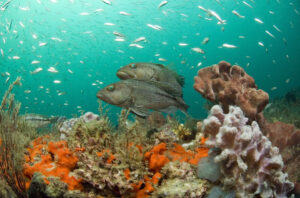The Modern Fish Act of 2018 (MFA) recognizes the differences between recreational and commercial fishing, adding additional management tools for policymakers to use in managing federal recreational fisheries. The MFA was a follow up to the Morris-Deal Report that emphasized the need to manage recreational fisheries based on long-term harvest rates, instead of strictly on poundage-based quotas.

Black sea bass at Gray’s Reef National Marine Sanctuary, Georgia. Photo credit: NOAA
The call for new recreational management approaches is based in part on the limitations of the Marine Recreational Information Program (MRIP), the survey used to estimate recreational catch. MRIP data are collected as a survey, not a census, leading to inherent uncertainties that create challenges when it’s used for fine scale quota management.
To account for these uncertainties, and their impacts on setting recreational bag, size and season, the Mid Atlantic Fishery Management Council (MAFMC) and the Atlantic States Marine Fisheries Commission (ASMFC) jointly embarked on a recreational management reform initiative for summer flounder, scup, black sea bass and bluefish. The goals of recreational management reform are to (1) provide stability in the recreational bag, size, and season limits; (2) develop strategies to increase management flexibility; and (3) align fishing access with availability and stock status.
The initial focus of the recreational management reform initiative was a suite of harvest control rules (HCR) that incorporate more scientific variables when determining management changes for the recreational fishery than just a comparison between estimated harvest and the harvest limit. Currently, every year, managers look at last year’s MRIP catch estimate and compare it to next year’s harvest limit and set the bag, size and season based on that difference which is a volatile and frustrating process. This knee jerk management response has been coined “chasing the recreational harvest limit.” The HCR alternatives aim to break that cycle of reacting to annual variability in MRIP estimates and instead look at stock status indicators (e.g., fishing mortality, biomass) to better inform the setting of bag, size and season and provide more stability for the fishery.
The American Sportfishing Association (ASA) has worked for several years with coalition partners and the ASMFC and MAFMC to help advance the HCR approaches to final action and implementation. In March 2022, ASA put together a guide to the HCR approaches to help the recreational fishing industry provide input to managers on preferred management changes. On June 7, 2022, after substantial input from the sportfishing community, ASMFC and MAFMC jointly approved the new HCR to improve recreational management.
The approved harvest control rule is called the percent change approach and has the following characteristics:
- It accounts for the variability and uncertainty of MRIP recreational harvest data when determining if changes to the measures are needed.
- It considers stock size (biomass) and harvest data compared to harvest limit with uncertainty accounted for when determining recreational bag, size and season limits.
The approved harvest control rule approach is anticipated to be used for 2023, 2024 and 2025 while several of the other HCR alternatives are developed further. Although the percent change approach represents a relatively small management change, ASA believes it will provide more stability to the fishery and we are committed to working on further improvements as the recreational management reform initiative moves forward.
For more information contact ASA’s Atlantic Fisheries Policy Director Mike Waine at mwaine@asafishing.org.
Share This Article, Choose Your Platform:
Recent Posts



